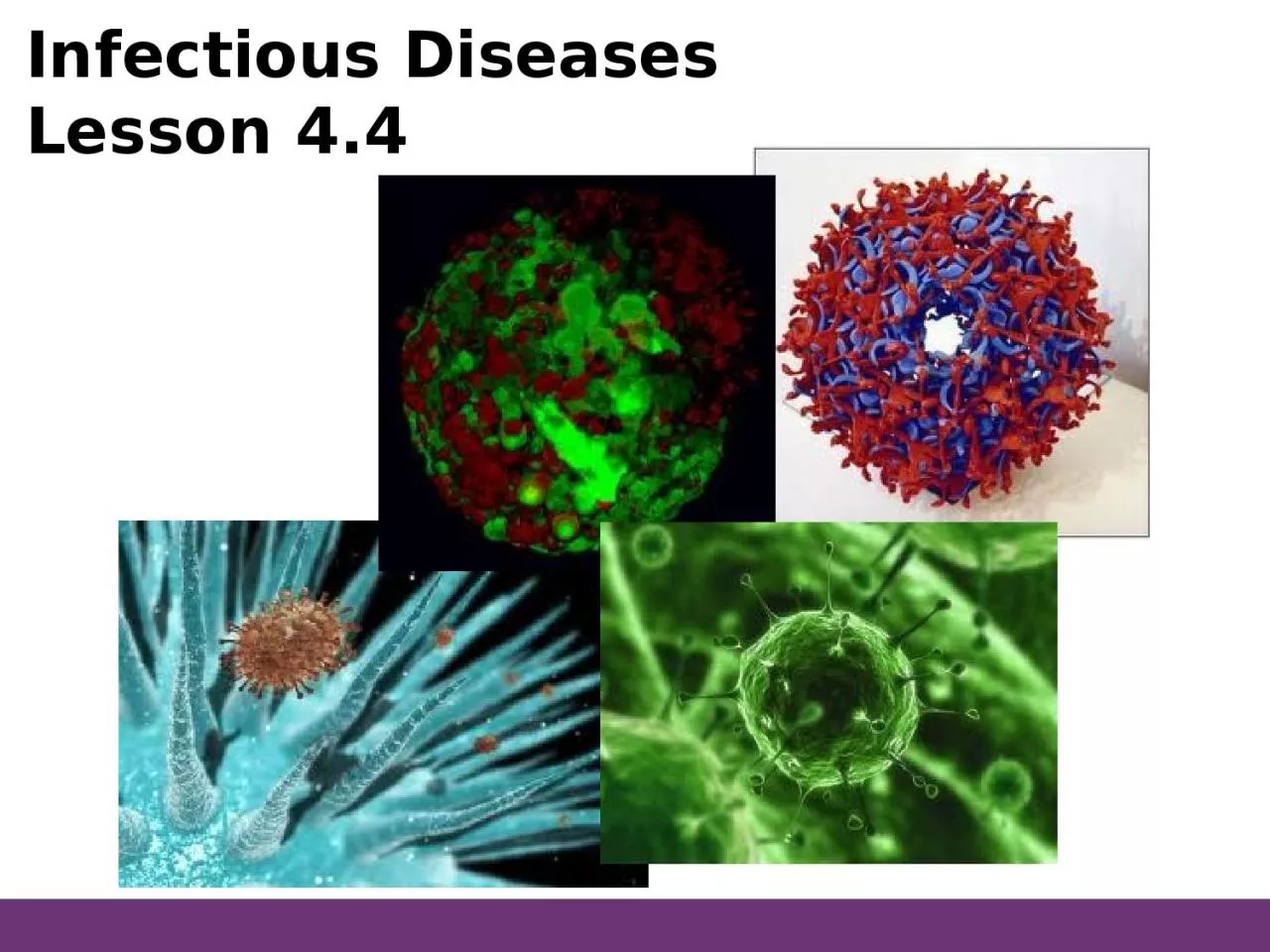

44 Lesson Objectives After finishing todays lesson you will be able to explain how viral replication leads to host cell lysis describe the replication of DNA and RNA viruses ID: 920439
Download Presentation The PPT/PDF document "Infectious Diseases Lesson" is the property of its rightful owner. Permission is granted to download and print the materials on this web site for personal, non-commercial use only, and to display it on your personal computer provided you do not modify the materials and that you retain all copyright notices contained in the materials. By downloading content from our website, you accept the terms of this agreement.
Slide1
Infectious Diseases
Lesson
4.4
Slide2Lesson Objectives:
After finishing today’s lesson, you will be able to
:
explain how viral replication leads to host cell lysis
.describe the replication of DNA and RNA viruses
.explain why RNA viruses carry special enzymes to copy RNA
.
Slide3Do Now
How do viruses cause damage and make us sick
?
Direct damage
Indirect damage
They cause host cell lysis
.
Slide4Discussion
The viral lifecycle has
FOUR
stages. Do you remember them from Unit 1?
The virus
attaches and enters the host cell.
The virus hijacks the host cell so it can replicate.The new viruses exit the host cell.‘How’ a virus exits depends on whether the virus is naked or
enveloped.
Slide5Step
ONE: Viral Entry
Can you remember the entry strategies for:
Naked viruses?Enveloped viruses?
Slide6How
NAKED
viruses enter host cells
The
naked virus
might
inject their genome through the
host cell
membrane: for example,
viruses that infect bacteria (bacteriophages)
.
The
naked virus
might be taken
up
by endocytosis and
then punch holes
in the endosome
m
embrane: for example,
polio virus.
Once the genome is in the cell
i
t
can begin to
replicate.
Cell membrane
Capsid & Genome
Nucleus
Slide7How
ENVELOPED
viruses enter host
cells
Because
the
enveloped virus
also
has
a membrane it
might fuse
with the
host
cell membrane:
e.g.,
HIV
The
enveloped virus
might be
taken
up
by endocytosis and then fuse
with
the endosome
membrane:
e.g.,
H1N1
Cell membrane
Once the genome is in the cell
i
t
can begin to
replicate.
Nucleus
Slide8Step
TWO: Viral Replication
Slide9The viral genome determines the structures of the host cell used during
replication
RNA viruses (their genome is RNA molecule)
DNA viruses (their genome is DNA molecule)
Slide10Before we can learn how viruses replicate we need to review molecular dogma!
DNA
RNA
Protein
Transcription
Translation
Replication
Slide11Cell membrane
Nucleus
Cytoplasm
RNA
Protein
DNA
Where in the eukaryotic cell do these processes take place
?
Transcription
Replication
Translation
Slide12They need to get their DNA into the nucleus
Herpesvirus
is a DNA virus
DNA
RNA
PROTEIN
DNA
viruses follow molecular
dogma
Herpesvirus
in a
Host cell
Slide13DNA viruses need
host proteins
to replicate
Herpesvirus
is a DNA virus
DNA
RNA
PROTEIN
Slide14RNA
RNA
PROTEIN
To
do this they
bring
specialized
enzymes with them.
H1N1
RNA viruses
defy
molecular dogma by making
RNA
from
RNA!
RNA-dependent
RNA polymerase
Slide15RNA
DNA
RNA
PROTEIN
Retroviruses such as HIV are
RNA viruses
2. They make
DNA
from
RNA
RNA viruses
defy
molecular dogma by making
DNA
from
RNA!
Slide16RNA
DNA
RNA
PROTEIN
Retroviruses bring the
reverse transcriptase
enzyme with them.
They use an
integrase
, to insert the DNA into the host genome.
To defy molecular dogma, retroviruses
bring
specialized
enzymes with them
Host DNA
Reverse transcriptase
Integrase
Slide17RNA viruses cannot correct errors
Random uncorrected mutations in RNA viruses cause
Antigenic
Drift (
will cover in lesson 4.5
)
DNA repair, P
roofreading (1 error in 100,000,000 bases)
No RNA repair
,
No proofreading (1 error in 100,000 bases)
Slide18Step
THREE: Viral Exit
Can you remember the exit strategies for:
Naked viruses?
Enveloped viruses?
Slide19Mature viruses
How
NAKED
viruses
exit
host
cells
The host cell fills with mature viruses and bursts.
This
is
called
lysis
.
Even bacteria can be infected by viruses!
This is a naked
virus,
called
a bacteriophage,
that infects
bacteria.
Slide20How
ENVELOPED
viruses
exit
host
cells
The new
envelope proteins
are collected
in
the host cell membrane.
The new
capsid proteins
and the
genome
collect below the envelope proteins.
The new
enveloped virus
forms and
buds off from the host cell.
The capsid pushes out and picks up envelope
The new virus buds off the membrane
Slide21Wrap Up
Compare and contrast
Naked
Enveloped
Entry
Exit
Naked
Enveloped
Entry
Injection
Endocytosis
Fusion
Endocytosis then
fusion
Exit
Host cell
lysis
Budding
Slide22Wrap Up
Compare and contrast
DNA viruses
RNA viruses
Location of genome
replication
Enzymes used to replicate the genome Mutation rate of polymeraseEnzymes used to integrate their genomes
DNA viruses
RNA viruses
Location of genome
replication
Nucleus
Cytoplasm
Enzymes used to replicate
the genome
Host DNA
polymerase
Viral RNA dependent RNA polymerase
Viral Reverse Transcriptase
Mutation rate of polymeraseLowHigh
Enzymes used to integrate their genomesUsually none
Viral Integrase
Slide23Homework
Complete the tables in your worksheet and review your notes.